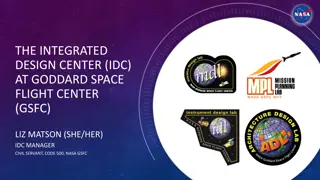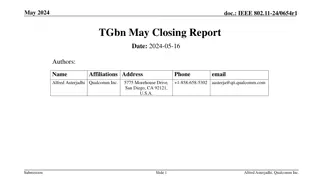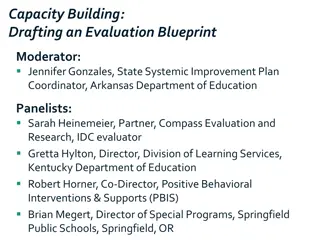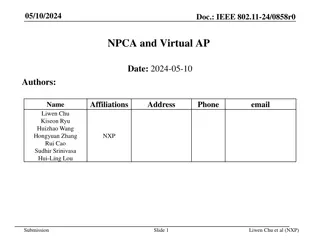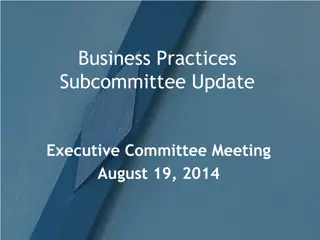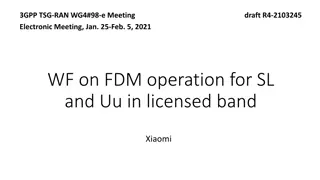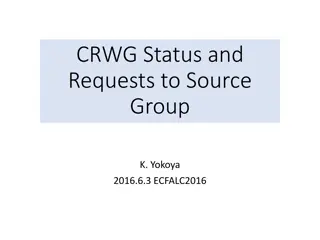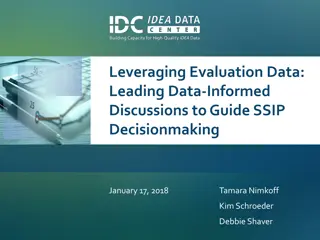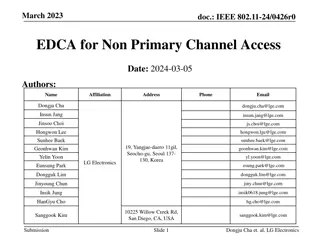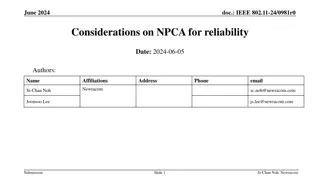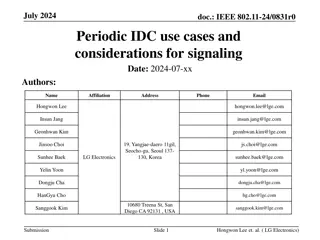NPCA Operation for IDC Management
In this document, the authors discuss the potential interference caused by IDC activity in IEEE 802.11 networks and propose the use of NPCA operation to mitigate this interference. Various types of IDC activities are identified, each impacting wireless communication differently. The document aims to enhance channel utilization efficiency and reduce disruptions in WLAN communication.
Download Presentation

Please find below an Image/Link to download the presentation.
The content on the website is provided AS IS for your information and personal use only. It may not be sold, licensed, or shared on other websites without obtaining consent from the author.If you encounter any issues during the download, it is possible that the publisher has removed the file from their server.
You are allowed to download the files provided on this website for personal or commercial use, subject to the condition that they are used lawfully. All files are the property of their respective owners.
The content on the website is provided AS IS for your information and personal use only. It may not be sold, licensed, or shared on other websites without obtaining consent from the author.
E N D
Presentation Transcript
September 2024 doc.: IEEE 802.11-24/1547r0 NPCA Operation for IDC Management Date: 2024-09-09 Authors: Name Juseong Moon Affiliations KNUT Address Phone email Jsmoon0211@a.ut.ac.kr Gwangho.lee@a.ut.ac.kr Gwangho Lee KNUT Woojin.ahn@ut.ac.kr Woojin Ahn KNUT Ronny Yongho Kim ronnykim@ut.ac.kr KNUT Submission Slide 1 Juseong Moon, KNUT
September 2024 doc.: IEEE 802.11-24/1547r0 Background In TGbn, there were discussions on the methods by which a STA indicates its IDC activity to its associated AP Some of the discussed methods have been adopted in the current SFD [1] The indicated IDC activity of the STA may interfere with a wireless medium. In this case, IDC activity could interrupt wireless LAN communication In other words, when the STA uses primary channel for IDC activity, other STAs including AP, may not be able to use primary channel due to the Tx power of IDC Channel utilization can be reduced due to IDC activity 11bn should consider further operations after the IDC indication for better channel utilization One of possible operations is NPCA operation [1-4] When an STA indicates IDC activity before the IDC activity begins, other STAs can use a non-primary channel that is not interfered by the IDC activity. Submission Slide 2 Juseong Moon, KNUT
September 2024 doc.: IEEE 802.11-24/1547r0 Types of IDC Activity Before discussing NPCA for IDC management, different types of IDC activity should be identified Type of IDC activity may vary In the next slides, various IDC activity types will be discussed Juseong Moon, KNUT Submission Slide 3
September 2024 doc.: IEEE 802.11-24/1547r0 Types of IDC Activity Type 1: No impact on 802.11 devices The IDC activity does not interfere with the IEEE 802.11 wireless medium, and IEEE 802.11 communications do not interfere with the IDC activity. Example: WLAN and IDC use different channels Juseong Moon, KNUT Submission Slide 4
September 2024 doc.: IEEE 802.11-24/1547r0 Types of IDC Activity Type 2: Impact on IDC communication The IDC activity does not interfere with IEEE 802.11 wireless medium, and IEEE 802.11 communications interfere with the IDC activity Example: WLAN is performing Tx while IDC is receiving in the overlapped channel Juseong Moon, KNUT Submission Slide 5
September 2024 doc.: IEEE 802.11-24/1547r0 Types of IDC Activity Type 3: Impact on 802.11 devices The IDC activity interferes with the IEEE 802.11 wireless medium, and IEEE 802.11 communications do not interfere with the IDC activity. Example: IDC is performing Tx while WLAN is receiving in the overlapped channel Submission Slide 6 Juseong Moon, KNUT
September 2024 doc.: IEEE 802.11-24/1547r0 Types of IDC Activity Type 4: Mutual impact on 802.11 devices and IDC communication The IDC activity interferes with the IEEE 802.11 wireless medium, and IEEE 802.11 communications interfere with the IDC activity. Example: WLAN is performing Rx&Tx, and also IDC is performing Rx&Tx in the overlapped channel Submission Slide 7 Juseong Moon, KNUT
September 2024 doc.: IEEE 802.11-24/1547r0 Interfering IDC Activity When wireless LAN communication interferes with the IDC activity, the wireless LAN should protect the IDC activity. Type 2: Impact on IDC communication Type 4: Mutual impact on 802.11 devices and IDC communication When the IDC activity interferes with wireless LAN communication, the wireless LAN will detect the wireless medium as busy. Therefore, wireless LAN may not use the wireless medium. Type 3: Impact on 802.11 devices Type 4: Mutual impact on 802.11 devices and IDC communication For these Types (Type 2, 3, 4), IEEE 802.11 WLAN cannot use a channel that is interfered by the IDC activity, or that interferes the IDC activity However, IEEE 802.11 WLAN can use a channel that is not interfered by the IDC activity, or that does not interfere the IDC activity. Submission Slide 8
September 2024 doc.: IEEE 802.11-24/1547r0 Difference between Unavailability and Interfering IDC activity Unavailability: A non-AP STA can be considered unavailable when: the non-AP STA cannot perform WLAN communication during IDC activity In this case, the AP shall not transmit to the non-AP STA. A non-AP STA can be considered available when: the non-AP STA can perform WLAN communication during IDC activity In this case, the AP can transmit to the non-AP STA. Interfering: A non-AP STA (or non-AP STA s IDC activity) can be considered interfering when: A non-AP s IDC activity interferes with WLAN BSS s primary channel A non-AP STA (or non-AP STA s IDC activity) can be considered not interfering when: A non-AP s IDC activity does not interfere with the WLAN BSS s primary channel Submission Slide 9 Juseong Moon, KNUT
September 2024 doc.: IEEE 802.11-24/1547r0 Difference between Unavailability and Interfering IDC activity Submission Slide 10 Juseong Moon, KNUT
September 2024 doc.: IEEE 802.11-24/1547r0 Difference between Unavailability and Interfering IDC activity When a non-AP STA is interfering and available in IDC activity: The non-AP STA can perform WLAN communication on a non- primary channel Other STAs, including the AP, can perform WLAN communication on a non-primary channel When a non-AP STA is interfering and unavailable in IDC activity: The non-AP STA cannot perform WLAN communication on a non-primary channel However, other STAs, including the AP, can perform WLAN communication on a non-primary channel Submission Slide 11 Juseong Moon, KNUT
September 2024 doc.: IEEE 802.11-24/1547r0 How can AP determine interfering IDC activity? At the current stage, the detailed method for IDC activity indication has not been discussed in detail. E.g., lack of frequency and bandwidth information, power information, etc., An AP needs more information about the IDC activity to determine whether it is interfering or non-interfering. When an STA with IDC activity provides detailed information about its IDC activity, its associated AP can determine whether the IDC activity is interfering or non-interfering. Based on the determination that the IDC activity is interfering with the wireless LAN, the AP can announce NPCA operation for its BSS to avoid the IDC activity. Submission Slide 12 Juseong Moon, KNUT
September 2024 doc.: IEEE 802.11-24/1547r0 Interfering IDC Activity Indication STA 1, which has a scheduled IDC activity , informs the AP with information about the IDC activity IDC activity of STA 1 impacts the primary 20MHz channel of the BSS The AP determines the IDC activity of STA 1 The information includes frequency information, time information, and various details about the IDC activity. When the AP determines that the IDC activity is interfering, it can announce NPCA operation. Slide 13 Submission Juseong Moon, KNUT
September 2024 doc.: IEEE 802.11-24/1547r0 NPCA Operations for IDC Management The AP is aware of the IDC activity, and when the IDC activity is interfering , the AP can trigger NPCA operation during the IDC activity. During the IDC activity, the AP and non-AP STAs can perform NPCA operation. If STA 1 is available during the IDC activity, STA 1 can also participate in NPCA operation. With NPCA operation, wireless LAN communication and STA 1 s IDC activity will not interfere with each other. Submission Slide 14 Juseong Moon, KNUT
September 2024 doc.: IEEE 802.11-24/1547r0 Next steps We can further consider the following: Exploring various types of IDC activity, including unavailability and interfering IDC activity Utilizing other channel access techniques (e.g., DSO) for IDC management Resource management for different types of IDC activity And so on Submission Slide 15 Juseong Moon, KNUT
September 2024 doc.: IEEE 802.11-24/1547r0 Summary This submission proposed NPCA operation to manage IDC interference When interfering IDC activity occurs, AP can inform about the IDC activity and non-AP STA can perform NPCA operation to avoid IDC activity. Detailed IDC indication should be considered to determine whether the IDC activity is interfering. IDC activity that interferes with IEEE 802.11 wireless LAN communication can be indicated and managed. With the proposed method, channel utilization of IEEE 802.11 wireless LAN can be maintained when IDC activity occurs. Submission Slide 16 Juseong Moon, KNUT
September 2024 doc.: IEEE 802.11-24/1547r0 Straw Poll #1 Do you support to modify the SFD as the following: 3.8 In-device coexistence 11bn defines a mechanism for a non-AP STA to report unavailability at TXOP level and define or reuse/update existing mechanism for a non-AP STA to report long term (periodic) unavailability. (Current SFD) The long-term unavailability report may include Occupying channel information Timing information (e.g., period, duration, offset) Y / N / A Submission Slide 17 Juseong Moon, KNUT
September 2024 doc.: IEEE 802.11-24/1547r0 Straw Poll #2 Do you agree the following?: 11bn non-AP STAs and AP can perform non-primary channel access when primary 20 MHz channel is occupied by reported periodic IDC. Y / N / A Submission Slide 18 Juseong Moon, KNUT
September 2024 doc.: IEEE 802.11-24/1547r0 References [1] 24/0209r4: Specification Framework for TGbn, https://mentor.ieee.org/802.11/dcn/24/11-24-0209-04-00bn-specification- framework-for-tgbn.docx [2] 23/1935r1: Secondary channel usage follow up, https://mentor.ieee.org/802.11/dcn/23/11-23-1935-01-00bn-secondary- channel-usage-follow-up.pptx [3] 23/2005r1: Non-primary channel access (NPCA), https://mentor.ieee.org/802.11/dcn/23/11-23-2005-01-00bn-non-primary- channel-access-npca.pptx [4] 23/2023r1: Further discussion in Non-Primary Channel Access, https://mentor.ieee.org/802.11/dcn/23/11-23-2023-01-00bn-further- discussion-on-non-primary-channel-access.pptx Submission Slide 19 Juseong Moon, KNUT



